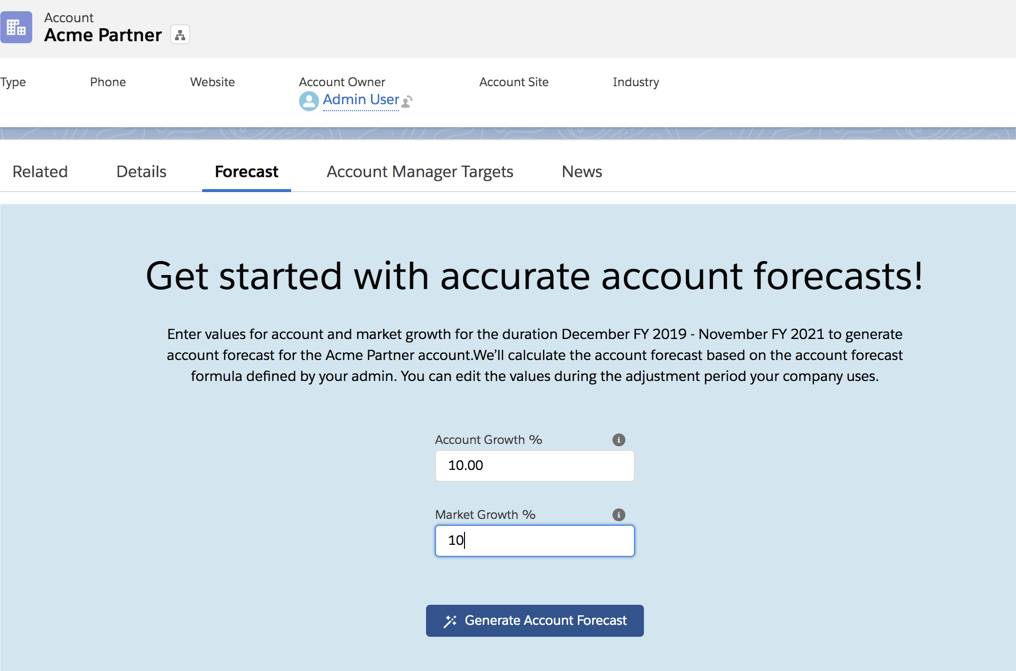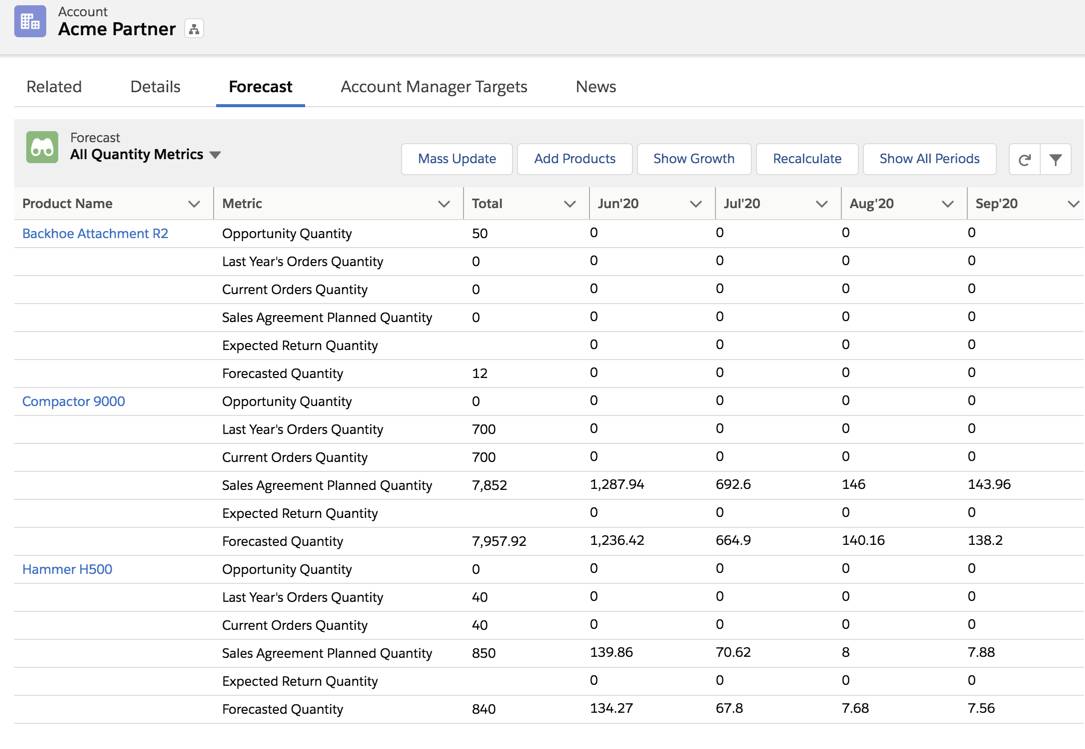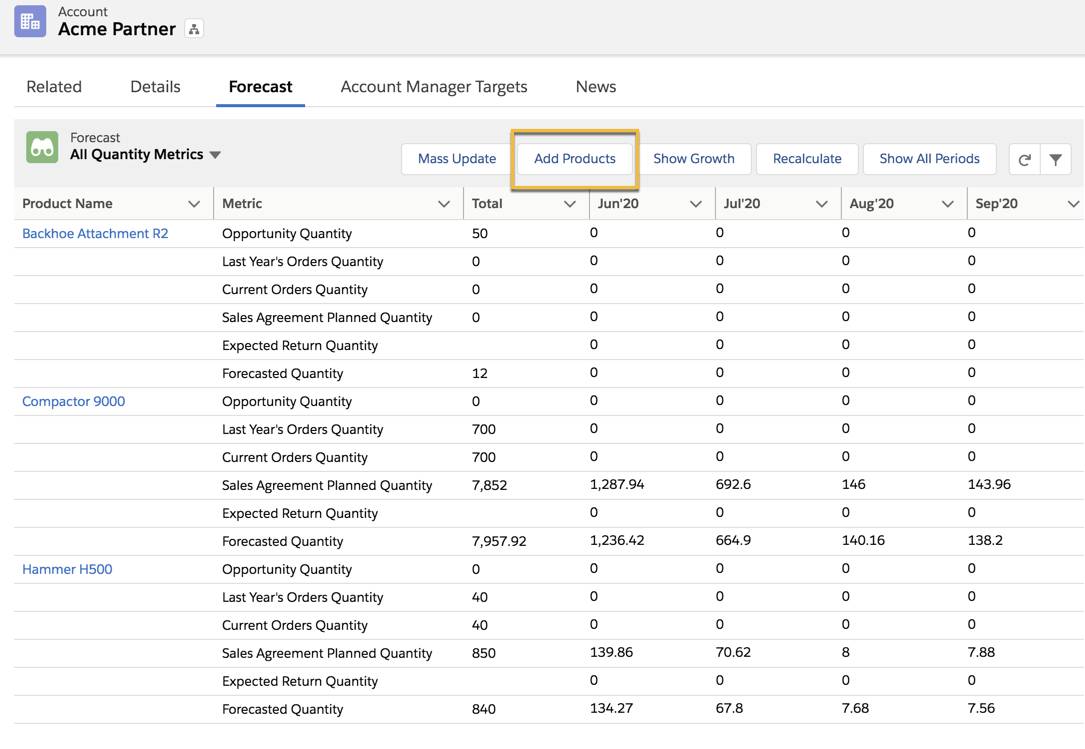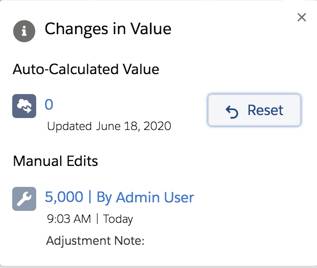Create Accurate Account Forecasts
Learning Objectives
After completing this unit, you’ll be able to:
- Generate a forecast for an account.
- Make adjustments to an account forecast.
- Add new products and recalculate forecasts.
What’s the Scope of Growth?
In Manufacturing Cloud Admin Essentials, Cindy, our fearless admin, set up account forecasting for Rayler Parts (see units 3 and 4 in that badge for a refresher of how she did it). The team is now going to put this feature to good use.
The current month is about to end, and Elliott has an important meeting with all account managers in his sales territory. He wants them to generate account forecasts before the meeting. The account forecasts provide the team a clear picture of new and run-rate business based on orders, opportunities, sales agreements, contracts, and custom metrics.
During the meeting, Elliott’s team plans to look at current commitments, demand patterns, the opportunity pipeline, and long-term agreements. These things help them decide on the adjustments they require for the forecast numbers.

Vance needs to generate the forecast for the Acme Partner account before the meeting. He’s pleased to know that Cindy accounted for account growth and market growth when she created the forecast formulas. This flexibility helps Vance create accurate forecasts for each account based on the degree of growth.
We've already generated forecast for the Acme Partner account in your special Developer Edition org. Here’s how you can generate forecasts for an account the first time:
- On an account record, click the Forecast tab.
- For Account Growth, enter
10. You expect your account to grow 10% for the upcoming month. - For Market Growth, enter
10. You expect the market for your products to grow 10% for the upcoming period. - Click Generate Account Forecast. Manufacturing Cloud sends you in-app notification when the forecast is ready. Crunching numbers takes some time! To view the results on the Forecast tab, refresh the page.

Vance now sees the Forecast tab filled with numbers. Cindy set up the forecasts to span 24 months. The current month is September 2020. Based on the start period, he can see the forecast from April 2020 to March 2022 for all the products. Click Show All Periods to load data for all periods. At the end of each month, the forecast rolls over.

Cindy also set up a forecast adjustment period. The team can edit forecast numbers only during the first 7 days of each month. September is in its last week, so Vance can’t update the forecast quantity or forecast revenue right now. The next adjustment window opens in the first 7 days in October. But he is all ready for the meeting.
Add Products and Recalculate Forecast
One of the key advantages of the account forecast feature is that it provides product-level granular details and can show you which products are faring well across accounts.
Vance and Elliott can see that for accounts selling Backhoe Attachment R2, the numbers are pretty good. Before the adjustment period is over, Vance wants to add this product to the forecast and run a recalculation. He speaks to Paula to see if there’s scope for sale of this product. Good news! Paula has been on the lookout for just such a product and wants Vance to introduce this new product when he runs the forecast.
Vance first creates an opportunity for the product and associates it to the Acme Partner account. To learn how to create an opportunity, see this help article. Now, Vance wants to recalculate the forecast to reflect the new opportunity and the new product. But first, he wants to change the market growth percentage. In the meeting, he found out that for the next few months, the market is growing faster than expected. He wants to account for this market growth in the calculations.
- On an account’s record, navigate to the Forecast tab.
- Click Show Growth.
- Change the Market Growth % to 15 and click Apply.
- The Recalculation process is automatically triggered with the new values. Edit the account and market growth percentage values, and click Apply.
Vance gets an in-app notification when the recalculation is complete. Refresh the page to see changes.

Next, Vance must introduce this new product into the Account Forecast. When Vance saves his changes. Manufacturing Cloud automatically calculates the forecast for the new product based on the formulas.
- In an account’s record page, click Add Products on the Forecast tab.
- Select the products you want to add. Vance selects Backhoe Attachment R2.
- Save your changes.
You can add a maximum of 50 products at a time to an account forecast.

The process has also calculated the forecast for the new product, and he can now see it on the Forecast grid!
Vance can also use the Filter action to view forecasts for selected products and time periods.
Make Adjustments Along the Way
Vance has a pulse on Acme Partner like never before. He can check out all deals with Acme in a single unified view down to orders and opportunities, and can see predictions at the granular product level. Based on the numbers, he can see that Acme Partner has been deepening its relationship with Rayler Parts, with the order quantities exceeding the distributor’s planned quantities for the last several months. Happy news indeed!
Vance explores the filters on the Forecast tab that can help him concentrate on sets of data at a time. He selects the All Revenue Metrics filter. Vance sees that the forecasted revenue line based on the historical data is trending upward. He hopes this relationship with Acme Partner grows over the next few months.
With Elliott’s meeting done, it’s time for the team to commit to numbers for the next month. They are utilizing the adjustment period of 15 days to collaborate on each others’ forecast, audit the quantities and revenues, and commit to certain targets based on past product performance and performance across accounts.
- Elliott wants to change the Forecasted Revenue for all products on the Acme Partner account page by 10%. Vance ignored the revenue potential, but Elliott knows that this adjustment will make the forecast more accurate. If history could speak, it would say that Rayler Parts has always seen a seasonal increase in revenue in the last quarter of a year.
- Elliott also wants to change the custom quantity metric for Additional Seasonal Sales by 20%. Cindy created and added this custom metric to the company’s forecast formula to account for seasonality. For example, during the fourth quarter last year, the company saw about a 20% increase in orders and opportunities. Now the production team has sufficient preparation to meet this new demand.
Luckily, when Elliott makes changes or updates to Vance’s account forecast, it’s recorded as part of an audit trail with notes. This makes it easy for Vance to know the degree of change and the reason behind it.
- On the Forecast tab of the Acme Partner account’s record page, click Mass Update.Note: Make sure the filter is selected as All Revenue Metrics.
- For Product, select All Products.
- For Period, select the last 4 periods.
- For Metric, select Forecasted Revenue.Note: You can update the values of all products or up to 350 products for all periods or multiple periods at once.
- For Action, select Increase By.
- For Value, enter
10and select the Use as percentage check box. - For Adjustment Note, enter
Based on trends, expecting bulk orders and growth in revenue. - Click Save.

To update the custom metrics, Elliott can ask the sales team to update the numbers in their external ERP system for additional seasonal sales. Those updated numbers are automatically updated for custom metrics on the forecast grid of the Account record.
It’s time for Vance to approve Elliott’s changes. He can choose to ignore the changes and reset the forecast revenue or seasonal sales to the auto-calculated values. But he knows better than that. Elliott’s business acumen is undisputed.
- Click
 in a cell. The icon indicates that the forecast value in that cell is modified.
in a cell. The icon indicates that the forecast value in that cell is modified. - Review the following information in the popover:
- The last auto-calculated forecast value.
- The last three manual edits, along with the User ID and adjustment note for each edit.
- Click Reset if you want to reject the manual edits and accept the auto-calculated forecast value.

Elliott and Vance now have complete visibility into the distributor’s data. Vance can always use Chatter and reach out to the production team to make them aware of changes in quantities. With accurate forecasts and strategic planning, business performance is predictable like never before.
Wrap It Up
Manufacturing is capital-intensive with complex physical operations, making it difficult to quickly adjust to changing circumstances. Before using Manufacturing Cloud, Vance relied on spreadsheets, which limited his ability to manage his sales agreements. He fell into a siloed and reactive engagement model with Acme Partner.
Now, with sales agreements and account forecasts, he has better visibility and comprehensive data. He can be flexible with his pricing to protect his margins, stop revenue leakage, and get better deals. Ease of business and collaboration across sales and operations have never been better at Rayler Parts.
